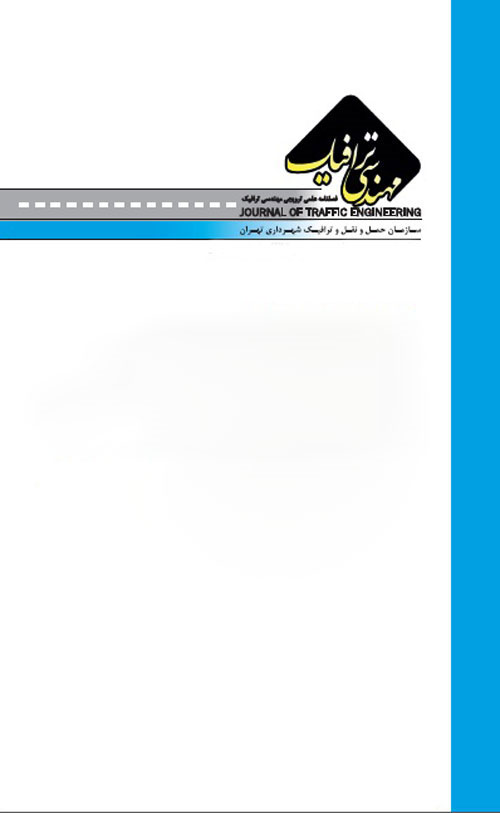فهرست مطالب

نشریه مهندسی ترافیک
پیاپی 55 (زمستان 1392)
- تاریخ انتشار: 1392/12/25
- تعداد عناوین: 7
-
-
Page 5This study focuses on drivers, behavior horn in a case study of Mashhad. Overall approach is qualitative and the main method is ethno methodology. For this purpose, various hooting styles were detected in Mashhad. Then the identified types of hooting were examined by five drivers. Data was described and analyzed by interpreting methods. The results showed that using horn, decreases law obediance. Therefore, using various hooting types Increases driving violence. Training at drivers in using of horn in various situation.Keywords: This study focuses on drivers_behavior horn in a case study of Mashhad. Overall
-
Page 13Annually, Millions of passengers and vehicles use country road networks which need different requirements. Constructing service complexes is a solution to provide passengers demands. In this paper, complexes construction budget, needed time of second phase timing and rate of interest for investers were modeled by ARENA software. Next, economical analyses were done by the output of COMFAR software. Statistical and traffic data are needed for real simulation. Some effective data such as arrival traffic of complex were obtained from AASHTO. Other required information were collected from transportation department of Kerman province.Keywords: Intercity service complex, ARENA, COMFAR, AASHTO
-
Page 21Children have problems in visual timing for safe road crossing and they are not able to combine visual timing elements (distance and speed) with fear and danger factors Based on previous studies, approximately 22 % of pedestrian fatalities are one of the most vulnerable groups in streets, accidents. The main goal of this paper was comparing and evaluating fear and danger feeling of children and combining them in four different traffic situations, considering age groups of pre-school, third grade of elemntry school, and adults. A table-top road model was used in this study and data was collected through interviews and observations. 82 individuals were selected through sampling process. Results showed that the main factor of children is fear. Data analysis was performed by descriptivel statistic methods such as: repeated measure analysis of variance, independent T-test, Runs test, and Kolmogorov-Smirnov test by SPSS statistical soft-ware.Keywords: pedestrian, children, fear, danger, speed, distance, instructional factors
-
Page 36New adays, increasing number of passengers vehicles has an important effect on transportation managements. Growing number of personal vehicles increases demands of parking. Lack of appropriate parking spaces imposes drivers to park in illegal areas such as no-parking areas , prohibited areas , in front of doors of house gates and on street traffic lanes). One of effective factors of using parking place is walking distance to the final destination. Utility of this distance depends on factors such as user characteristic, travel purpose, Parking location, variety of surrounding landuses, parking fees, and etc. The main goal of this paper is to find important factors of desirable walking distance to final destination by SPSS 20 software. The study was done by interviewing 111 people in parking lots of study-area. According to the results, the most important factors of desirable walking distance from parking to final destination in the city of Ahwaz included: user occupation, free parking, proper width of sidewalk, and weather conditions.Keywords: Private car, Parking, Transportation demand management, Walking distance, Walkability
-
Page 43Gap and follow-up time are two important parameters in un-signalized intersection and capacity calculation. Due to great capacity and high velocity of conflicting traffic on important urban roads , applying U-Turn action needs proper gap and follow-up time. Thus, U-Turn action always encounters safety and efficiency problems. Many methods have been introduced for calculating critical gap like Logit, Raff, Maximum Likelihood (MLE), and HCM methods. In this paper, data were collected from four opening median located on arterial roads in Rasht, a follow-up time and the critical gap model were developed by linear multiple regression analysis. Results showed that increases vehicle total delay time in U-Turn action reduces critical gap and increases vehicle speed in conflicting traffic areas. Also, based on the conclusions, increasing the ratio of followup time to critical gap reduces of U-Turn in opening medians.Keywords: Gap, follow-up time, U-Turn, MLE, HCM
-
Page 55Keeping traffic flow density and air pollution in an acceptable level and providing appropriate transit capacity is a big deal in large and crowded cities. To address this problem, a new method of intersection signal optimization is presented in this paper. Traffic metering strategy was developed for controlling traffic density in high priority areas. Preventing network gridlock, optimizing queue ratios on entrance arterials, and utilizing reserved capacity were the main objectives of the problem. A traffic simulator software (VISSIM) was used for simulation and the coded program was developed inVISSIM-COM interface. Finally, the model was applied on a network with a traffic pattern similar to Tehran network. The results showed that redistributing traffic density in the whole network and protecting high density areas from gridlock could efficiently improve traffic flow measurement in high priority areas. On the other hand the new strategy could significantly improve queue ratios on entrance arterials.Keywords: VISSIM, queue ratio, Traffic managment
-
Page 62Many of the researches in transportation planning are associated with making modeling route choice behavior. The precision and efficiency of many decisions in transportation network design or network pricing depends on the accuracy of forecasting equilibrium traffic pattern. Accordingly, in recent years, there has been considerable attention in developing more generalized, accurate and sensitive traffic assignment models. This research introduces and develops an innovative approach in traffic assignment in order to enhance the accuracy and flexibility of route choice modeling and enjoying sounder assumptions in traffic equilibrium analysis. The presented approach includes of a multiclass and multicriteria traffic assignment model by using generalized extreme value (GEV) models for representation of commuters decisions. The methodology was elaborated and the model was investigated on networks.Keywords: GEV models, multicriteria, multiclass, transportation network

